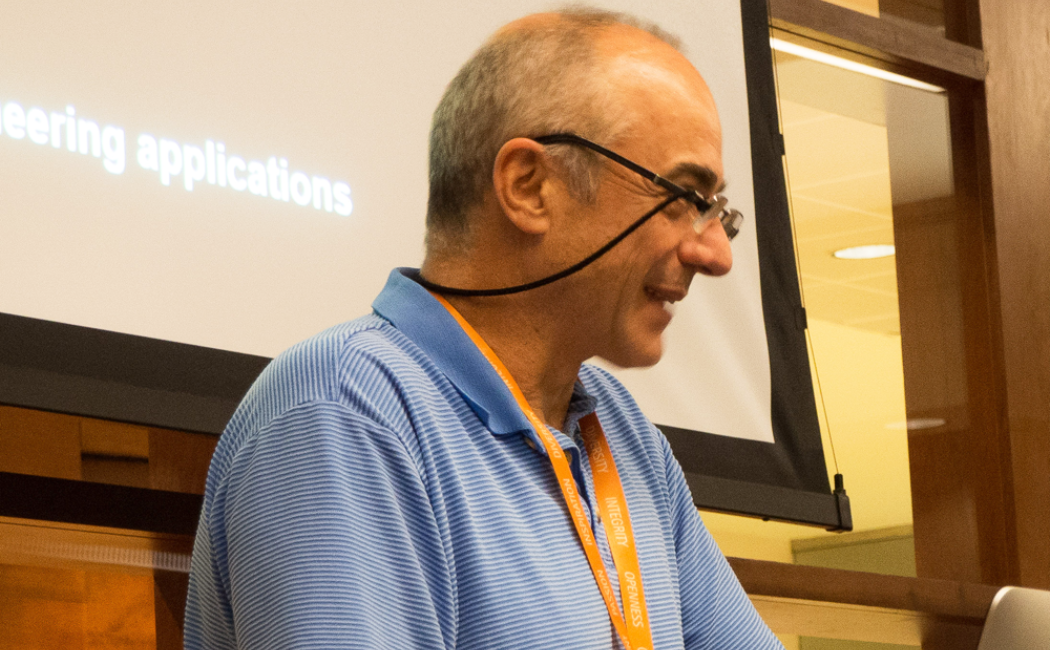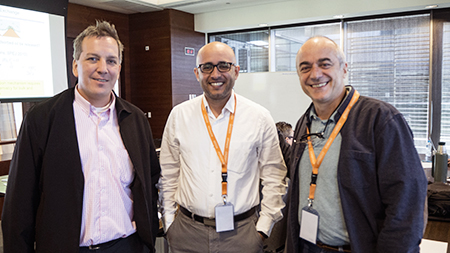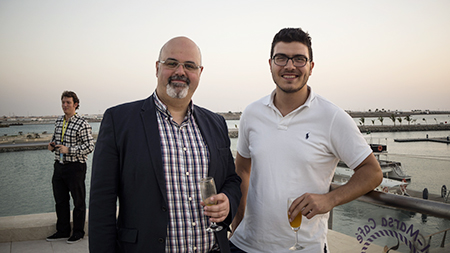.jpg?sfvrsn=39330263_0)
.jpg?sfvrsn=39330263_0)

28 April, 2016
 Click here to see a brief video: KAUST Athenaeum of Dissolution and Precipitation from KAUST Video on Vimeo.
Click here to see a brief video: KAUST Athenaeum of Dissolution and Precipitation from KAUST Video on Vimeo.
Click here for photos on Flickr.
The scientific and engineering culture at ANPERC can be characterized simply: open-minded. 
At the center’s first technical event, the KAUST Athenaeum on Dissolution and Precipitation, held on campus February 7-10, 2016, being open-minded extended to every part of the event. It’s something that Prof. Carlos Santamarina, the event’s organizer and host, takes to heart even when he invited participation to a last-minute change to the packed schedule.
“Let’s take a tour of the center labs. Just be careful, they’re under construction!” said Santamarina on the second day just after lunch.
More importantly, the KAUST Athenaeum was structured to encourage open-minded approaches to one of the most important natural phenomena related to the development of oil and gas reservoirs, and all kinds of geologic structures: the thermo-chemo-mechanical-bio processes that are at play over millions of years, and that involve mineral dissolution and precipitation.
To ensure that this complex topic could be approached in a broad and open-minded spirit, Santamarina invited over thirty of the leading academic and industry researchers from fields including Chemistry and Chemical Engineering, Physics, Civil Engineering, Petroleum Engineering, Geophysics and Geosciences, and Mathematics. He designed a unique workshop in the format of an athenaeum, a classical term for the scientific “meeting of the minds.” Unlike a traditional academic conference, the KAUST Athenaeum featured brief-yet-comprehensive overviews of different topics or challenges in the field of dissolution and precipitation, then organized the participants into smaller teams to work through those challenges. The goal of the KAUST Athenaeum was to create a state of the art in dissolution and precipitation studies, and chart potentially fruitful paths for the discipline to explore through future research.
 For Alejandro Cardona Ramirez, a Ph.D. student in Santamarina’s group, the athenaeum’s unique structure provided an unparalleled professional experience.
For Alejandro Cardona Ramirez, a Ph.D. student in Santamarina’s group, the athenaeum’s unique structure provided an unparalleled professional experience.
“When Professor Santamarina first told me about the workshop last September, my expectations were enormous; I  quickly began to comprehend how rewarding and unprecedented of an academic experience it would be,” said Cardona Ramirez. “Once the workshop finished, the final result greatly surpassed my expectations. The uniqueness of this event was highlighted in the convergence of knowledge of very sharp minds from various areas of expertise, with a common goal in mind: to better understand precipitation and dissolution processes by looking at these phenomena from different points of view. I am extremely honored to have been a part of this kind of event and this Athenaeum will work as a model to follow in future conferences.”
quickly began to comprehend how rewarding and unprecedented of an academic experience it would be,” said Cardona Ramirez. “Once the workshop finished, the final result greatly surpassed my expectations. The uniqueness of this event was highlighted in the convergence of knowledge of very sharp minds from various areas of expertise, with a common goal in mind: to better understand precipitation and dissolution processes by looking at these phenomena from different points of view. I am extremely honored to have been a part of this kind of event and this Athenaeum will work as a model to follow in future conferences.”
For most of the delegates, attending the KAUST Athenaeum on Dissolution and Precipitation demanded an open mind. The range of topics and concepts—and the vastly different backgrounds of the delegates—encouraged strong intellectual exchanges.

 “I had (high) expectations because I work on the fundamental aspects of precipitation and dissolution, both theoretically and experimentally so I thought I’d have the opportunity to exchange ideas with engineers and geophysicists,” said Mazen Al-Ghoul, Professor of Chemistry at American University of Beirut, Lebanon. “What I experienced over the last two days was beyond my expectations. I never thought that geophysics, geochemistry and engineering aspects were as exciting as they are. This will be an unforgettable experience that I can bring back to my students in Beirut.”
“I had (high) expectations because I work on the fundamental aspects of precipitation and dissolution, both theoretically and experimentally so I thought I’d have the opportunity to exchange ideas with engineers and geophysicists,” said Mazen Al-Ghoul, Professor of Chemistry at American University of Beirut, Lebanon. “What I experienced over the last two days was beyond my expectations. I never thought that geophysics, geochemistry and engineering aspects were as exciting as they are. This will be an unforgettable experience that I can bring back to my students in Beirut.”
Most of the delegates were visiting KAUST for the first time. In addition to having nightly assignments in collating and summarizing the day’s thinking, ANPERC provided opportunities for the attendees to get a sense of the broader student population, according to Julia Gale, Research Scientist from the Bureau of Economic Geology at the University of Texas at Austin.
“The real diverse nature of the student body, the ones I met, they’re from all over the world—it’s clear that was something King (Abdullah) wanted in the mission,” she said.
The KAUST Athenaeum on Dissolution and Precipitation acted as a catalyst for the formation of a strong community of scholars focused on advancing the field and discerning its implications. “Beyond the group of participants, the library we have put together and the annotated slides that define today’s state of the art are most valuable resources for researchers working in this field around the world.”
The hope is that these outputs from the KAUST Athenaeum on Dissolution and Precipitation will drive new approaches to tackling these problems, positioning KAUST and ANPERC among the driving forces in this field of research.
Learn more about the KAUST Athenaeum by visiting the event’s microsite.
The KAUST Athenaeum on Dissolution and Precipitation was organized by Prof. J. Carlos Santamarina and ANPERC with generous financial support from the KAUST Office of Sponsored Research. Additional support was provided by the KAUST Industry Collaboration Program, Industry Engagement Office

